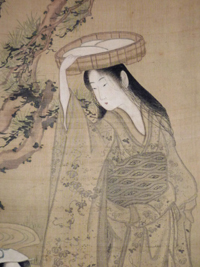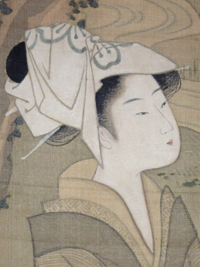Kubo SHUMMAN (1757-1820)
Click here to view image full size.
A fine painting showing a seated girl fulling cloth ( a process of beating which eliminated the dirt and other impurities ) with another standing beauty holding beaten cloth in a wooden tray on her head. This scene represents Mishima, or Toi, Province of Settsu. One of the Six Crystal ( Tama ) Rivers. ( Toi is the alternative name of the river and the word for beating cloth. ) This was probably Shumman’s most celebrated subject. He produced a set of six prints on this theme published by Fushimiya Zenroku, c 1787. One of the most beautiful 18th century sets, and together with a night triptych showing people returning from a poetry reading, is considered his masterpiece. The prints and the known paintings of this subject use the benigirai style, “red avoiding” pioneered by Shumman, Eishi and Shuncho. Shumman, a man of great sophistication, designed only a few prints before concentrating on surimono and printing and issuing some of the finest in this format. ( See The Japanese Print A New Approach, J. Hillier, pp. 102-104: “Probably no artist except Choki has achieved so high a reputation on such a small number of prints.” ) He also excelled at painting, book illustration and light verse. Painted on silk in tones of sumi, very light green, gofun and a small touch of red on the girls’ lips. Image size: 36 x 12 in; 91.5 x 30.5 cms. Other versions of this subject are in the BM ( 1922.2-13.01 ) and the Freer Gallery of Art ( FI903.62 ), gift of Charles Freer. Painted c early 1790s. Slight loss of gofun and very minor spotting, but otherwise in very good condition. Interesting old mount. Exhibited in 1995 at Shunsen Museum in Nanamashi prefecture, Nikushitsu ukiyoe meisaku ten, hosted by Mr Keizaburou Yamaguchi, p. 40, no, 37. Painting guaranteed by Mr Narazaki, the box being signed and dated 1988 by him. Signed Shosado Shumman, with circular Shumman seal.
Status: Sold






